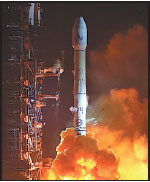Satellite to study lightning, pollutants
China launched a new-generation weather satellite on Sunday that can improve weather forecasting as well as help study lightning and air pollutants, including PM2.5.
The 5.4-metric ton Fengyun 4A, developed by the Shanghai Academy of Spaceflight Technology, was launched at 12:11 am atop a Long March 3B carrier rocket from the Xichang Satellite Launch Center in Sichuan province, according to the State Administration of Science, Technology and Industry for National Defense, which is overseeing the satellite project.
The country's latest geosynchronous meteorological satellite will gradually replace the Fengyun 2 satellites, the administration said in a statement.
|
A Fengyun 4A weather satellite is launched on Sunday in Xichang, Sichuan province.Chen Jianli / For China Daily |
The Fengyun 4A will work 36,000 km above the Earth for seven years, monitoring the atmosphere, clouds and the space environment above China and the western Pacific and Indian oceans.
The satellite will help with meteorological forecasting, disaster prevention and relief, climate change response and environmental monitoring, the statement said.
Yu Xinwen, deputy director of the China Meteorological Administration, said: "The Fengyun 4A will help China remain one of the top developers of weather satellites. It is the first of its kind in the world that is capable of performing multichannel observation of the atmosphere."
Dong Yaohai, chief designer of the satellite at the Shanghai Academy of Spaceflight Technology, said the satellite has four instruments - an advanced geosynchronous radiation imager, a geostationary interferometric infrared sounder, a lightning mapping imager and an instrument to monitor the space environment.
The lightning mapping imager is capable of taking 500 pictures of lightning within one second, and these images will extensively facilitate research on lightning's frequency and effects, he said.
The advanced geosynchronous radiation imager will calculate the density of PM10 and PM2.5, both of which are toxic particulate matter that is harmful to health.
"The Fengyun 4A is as advanced as the newest weather satellites developed by the United States, Europe and Japan," the designer said. "It is highly sensitive, since it is able to detect a temperature change of 0.1 C on the ground."
Zhao Jian, an official in charge of the project at the State Administration of Science, Technology and Industry for National Defense, said China plans to launch the Fengyun 4B in 2018 and the Fengyun 4C in 2020.
The country will also send some other weather satellites in the near future, including two rain monitor satellites and one greenhouse gas detection satellite, he said.
China launched its first weather satellite, the Fengyun 1A, in 1988. It now operates seven weather satellites - four in the Fengyun 2 series and three in the Fengyun 3 series, according to the administration.
zhaolei@chinadaily.com.cn



















